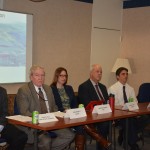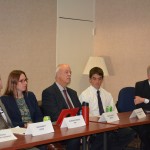Several high ranking transportation officials and experts gathered at Saint Peter’s on Friday, November 13 to address the most pressing transportation issues in the New York metropolitan area and the measures needed to improve them.
The panel of experts included: Drew Galloway, chief of planning & performance for Amtrak North East Corridor; New Jersey State Senator Bob Gordon; Courtenay Mercer, NJ director of the Regional Plan Association; NJ Transit Chief Planner Jeremy Colangelo-Bryan; and Christopher Ward, senior vice president of AECOM and former executive director of the Port Authority of New York and New Jersey.
Philip Mark Plotch, Ph.D., director of Saint Peter’s master’s program in public administration, moderated the forum, which touched upon various hot topics such as the challenges of an increasingly decaying and congested transportation system, measures being taken to explore potential solutions and updates on current infrastructure projects as well as ones that are still in the planning process.
“If something goes wrong, we’re talking about something catastrophic — 80,000 commuters will need to find another way to get to work,” said Sen. Gordon. “If a tunnel goes down, we’re in serious trouble.”
Among the several potential projects being discussed, officials primarily focused on the approved Gateway Program, which will ultimately increase track, tunnel, bridge and station capacity. The program, which is currently in the planning process, will eventually create four mainline tracks between Newark, New Jersey and New York Penn Station, including a new, two-track Hudson River tunnel.
“This is a matter of survival of keeping the tunnels safe,” said Galloway. “Once we have this, we will have an asset that will be good for another 100 years.”
Describing it as “one of the most important infrastructure projects in America,” Sen. Gordon pointed out the importance of how the project will be funded. Recently, an agreement was reached where the states of New Jersey and New York will pay 50 percent and the federal government will provide a grant that will foot the other 50 percent.
“The agreement that was worked out is very significant. Yes, the incurred costs will be high, but they’re doable, added Sen. Gordon. “Now we just need the leadership to move this project along; we have to get both states to be willing to work with one another.”
Mercer pointed out that the Gateway Program was not just about bolstering the tunnels, but also all the existing capacities between Newark Penn Station and New York Penn Station.
“Other upgrades and having redundancy in the system is really important,” she added. “We need to invest in all infrastructures in general if we are to stay a prime world economy, period.”
Bennett provided insight into the complexity and feasibility of the Gateway Program and similar projects, citing that the real issues were with getting the paperwork completed and the permits necessary to begin the work.
“There’s a two to four year period just for the planning for the tunnel section [of the Gateway Program],” he explained. “I think 10 years is a reasonable horizon for it to be completed.”
The officials confirmed all projects would address making new and existing infrastructures resilient against natural disasters as well as taking into account keeping transportation costs at a manageable level.
“People make specific choices on how to move across this complicated region; we need to be thoughtful about the whole program,” said Colangelo-Bruan. “In the end, it’s all about the people and making their trips reasonable.”
The panel discussion was sponsored by the Regional Plan Association, the Guarini Institute for Government and Leadership and the Master of Public Administration program at Saint Peter’s University.



